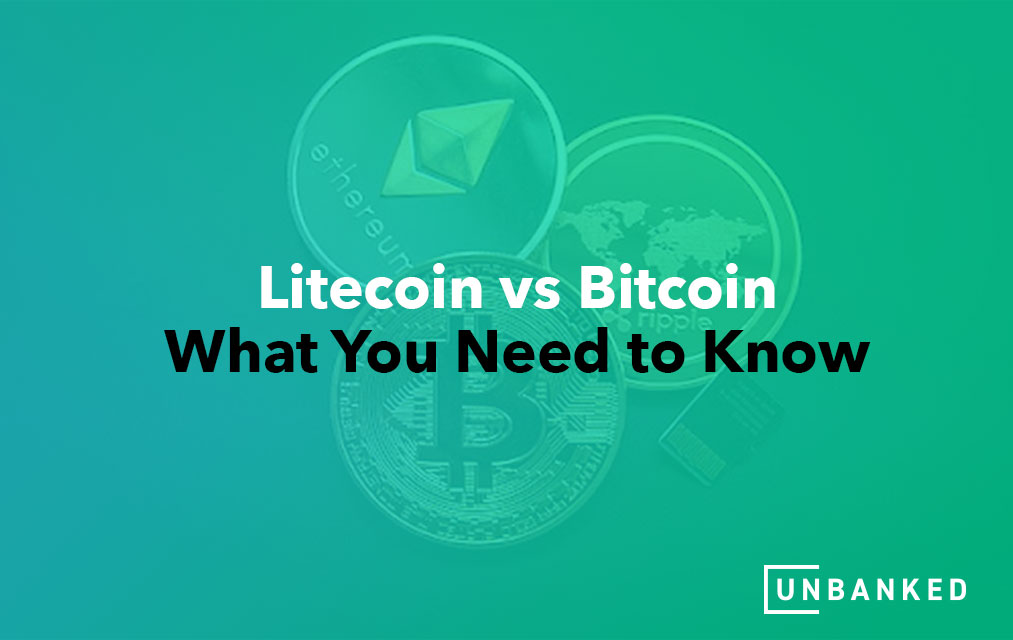If you have been watching the market, you might have seen a rise in investors’ interest in cryptocurrencies. 2020 was a big year for these cryptos. While the main focus has been on Bitcoin, other types of digital money might pique the interest of those would-be investors. However, Bitcoin continues to dominate the market. If you are ready to take a dip into the crypto investment pool, here are a few things that you should know.
What Are Cryptocurrencies?
Bitcoin was founded in 2009, but it is not the only cryptocurrency on the market. There are plenty of other types of digital money in the crowded field. Litecoin (LTC) has been one of the main competitors of Bitcoin. Litecoin was founded two years after Bitcoin. Based on its market cap, LTC is the sixth-largest digital currency, trailing behind Bitcoin. Since March 2021, Litecoin has a $413.7 billion market cap, while Bitcoin leads the pack at $1 trillion.
Are you thinking about investing in digital currencies? Unbanked can help you buy, sell, or send crypto!
However, Litecoin is beating Bitcoin in other areas. For example, Litecoin can create more coins than Bitcoin. With that, it has a faster transaction speed. In fact, it is leading the market in this category. While these factors do not impact the usability or value of the currency, they can significantly boost an investor’s confidence, meaning that these indidvuals are more willing to transact with this currency over other choices.
Along with that, Litecoin and Bitcoin use different types of cryptographic algorithms. Litecoin relies on the newer algorithm called Scrypt, while Bitcoin uses the SHA-256 algorithms.

Bitcoin: A Closer Look
Like all types of cryptocurrencies, some concerns still surround these investments. Here is a more in-depth look at Bitcoin.
Total Supply
If you are wondering about the total supply of Bitcoin, there are about 21,000,000 worldwide. Through the process of mining, new Bitcoin is introduced into the market. Miners are rewarded with a fixed amount of crypto when they solve a mathematical problem. That is what is known as a block reward.
You will notice that the Bitcoin mining network is adjusted when there is a change of mining power. With that, the supply of Bitcoin is always predictable. Today, the inflation rate (also known as block reward) started out at 50, but it is halved every four years. If you are worried about sustainability, there are estimates that miners will mine the last Bitcoin in 2140.
Transactions Per Second
Bitcoin is pretty fast with its transactions. It is estimated that this crypto can process transactions at the rate of 3.3 to 7 transactions per second (TPS). On the other hand, Visa can complete about 1,700 TPS on average. What makes the difference? One is decentralized while the other is centralized.
The previous block on Bitcoin’s blockchain is validated by all of the users on the network. As a new block is created and added, all that information is added to the network, making the network a little more secure.
Visa does not have to reconcile with those thousands of nodes on the network, resulting in a faster transaction time. Instead, the information floods through a centralized database controlled by authorized users.
Scalability Solutions
Over the years, developers have created many scalability solutions. However, since Bitcoin by nature is decentralized, many of these solutions have failed to be implemented.
One hot topic is the issue of increasing the block size limit of Bitcoin. If the limit was raised, then Bitcoin could process more transactions in a timely manner. However, many of these changes are met with resistance from the Bitcoin mining community. As a result, there has been a network split with the creation of Bitcoin cash. This BTC cash has a block size limit of 32 megabytes, while Bitcoin currently ranges at 4 megabytes.
Privacy Features
You might think that Bitcoins are private, but those transactions are very transparent. These transactions can be made confidential by using additional services and privacy apps. You should know that all confidential transactions are not implemented into the leading Bitcoin network.
All-Time Highs
On February 21, 2021, Bitcoin reached an all-time high when the price reached $58,640. That beat the previous record set in late 2017 and early 2018. Some analysts believe that those values will continue to rise and could hit $100,000 by the end of the year.
In this current bull market, there has been a substantial increase in those investments from institutional investors. While many investors stayed away during the previous surge, they have seen the benefits of crypto investing, leading to the recent gains.
Total Capitalization
Today, Bitcoin’s total market capitalization hovers around $901.56B. With that, it is on the path to becoming the first cryptocurrency to hit the $1 trillion benchmark. Bitcoin has a 59% share of all capitalization in the cryptocurrency industry, giving investors plenty of confidence in this crypto.
Litecoin: A Closer Look
Now that you know about Bitcoin, let’s take a look at Litecoin.
Total Supply
Compared to Bitcoin, Litecoin has a larger supply of over 84 million. Currently, about 79% of all Litecoin is in circulation. Like Bitcoin, the number of Litecoin will halve about every four years. It is expected to be entirely mined by the year 2142.
Scalability Solutions
While Litecoin is the more scalable blockchain, its developers have employed different methods to help Litecoin scale. Litecoin borrows many of Bitcoin’s protocol improvements and scalability. One layer of scalability is known as the Lightning Network. While some services have integrated LN into their networks, there has not been a worldwide acceptance since it is still at the experimental stage.
However, Litecoin developers are working hard to integrate layer one scalability solutions into the crypto. MimbleWimble (MW) has been one of their latest attempts. With this solution, transactions can be secure and confidential. However, some have argued that MW can increase scalability but decrease the block size. With this solution, Litecoin is not required to run on a different network. In many cases, MW will only affect a small portion of the main network.
Block Time
Bitcoin has a block time of 10 minutes, but the block time of Litecoin is significantly shorter. Since Litecoin has a 2.5 minute transaction time, this is the better choice for those daily transitions.
According to multiple sources, the TPS for Litecoin is about 28 transactions per second. That is about three times more than Bitcoin, but it still ranks far below the TPS of Visa. Once again, Litecoin requires consensus for every block on the network, while Visa’s transactions are sent to a centralized location.
Privacy Features
To help with the confidence transition, Litecoin has introduced MW into the codebase. With that, the fungibility of Litecoin should improve those privacy features. The fungibility keeps all digital assets distinguishable from each other, making them interchangeable. With that increase in privacy, it would be harder to monitor the ownership and movement of Litecoin.
All-Time Highs
On December 18, 2017, Litecoin reached its all-time high at $360. Even though there is still a bull market, Litecoin has not broken that record. However, slime experts believe that Litecoin’s value will continue to rise, especially when more well-established financial institutions recognize the importance of this cryptocurrency.
Total Capitalization
Today, Litecoin has a total market capitalization of $12.11 billion. When Litecoin reached its all-time high, it had the highest total market value at $19.6 billion. As previously mentioned, with increasing interest from investors, Litecoin should surpass those numbers in the next few years.
Now that you know about the basics of these two types of Litecoin, here are the similarities and differences of these cryptocurrencies.
Are There Similarities Between These Currencies?
At a glance, you might think that Litecoin and Bitcoin have many things in common. They are both considered decentralized cryptocurrencies. When you compare them to fiat currencies, such as the Japanese yen or U.S. dollar, these currencies have the backing of a centralized bank, which boosts its legitimacy and controls circulation. With Litecoin and Bitcoin, there is no backing. They only rely on the network’s integrity of the cryptographic market.
When Litecoin debuted in 2011 by Google engineer Charlie Lee, these cryptocurrencies were seen as the “lite version of Bitcoin.” As a result, Litecoin has always been viewed as the direct competition of Bitcoin. The developers of Litecoin have called their product the “silver” equivalent of Bitcoin’s “gold.” You might notice that Litecoin has many of the same features as Bitcoin by incorporating those well-known aspects in this digital currency while improving on other areas.
Related: Cryptocurrency for Beginners
What Is Proof of Work?
If you are looking at the similarities of Bitcoin and Litecoin, both of these cryptocurrencies have proof of work ecosystems. What does that mean for an investor? These two digital currencies have a particular process for how they are mined for generation and authentication. Once that is completed, these currencies are added to a public ledger, also known as a blockchain.
Storage Options for Digital Money
Many investors are worried about the transaction elements of these digital currencies. With Bitcoin and Litecoin, these currencies both work in similar ways. These cryptocurrencies can be mined or exchanged with a mining rig. You can store the crypto in a digital wallet until you need it for a transaction. Plus, with these cryptocurrencies, the prices have been subjected to market volatility where government regulations and investor interest have influenced.
What Are the Differences Between Litecoin and Bitcoin?
When you compare Bitcoin and Litecoin, they have different market capitalization and total dollar market value of the coins. Since March 2021, Bitcoin has a total value of $1 trillion, and it is almost 70 times larger than Bitcoin.
If you are worried about the market cap of Bitcoin, you need to take its value into historical terms. In July 2010, Bitcoin’s market capitalization was about $42,000, and when compared to today, those numbers are staggering. For that reason, Bitcoin is still the leader in the digital currency marketplace. The only closest competitor is Ethereum, which enjoys a market cap of $212 billion. When you think about it, Bitcoin has a higher value than Litecoin, which is because Bitcoin has been around much longer than other types of currencies.

Distribution of These Coins
When it comes to distribution, Bitcoin and Litecoin vary. Litecoin pulls ahead of the pack in different ways as it can accommodate up to 84 million coins, while the Bitcoin network cannot exceed 21 million coins. While that might seem like an advantage to Litecoin, those benefits can be negligible in the real world. Since Bitcoin and Litecoin can be divisible into infinite amounts. For example, Bitcoin has a minimum transferable quantity of one hundred millionth bitcoin, which is also called a “satoshi.” With that, these digital currencies users can still purchase low-priced services and goods, despite the general prices of the undivided Litecoins or Bitcoins. With that, Litecoin has a more significant number of coins that can be purchased simultaneously, which has a physiological advantage for many investors.
In November 2013, IBM executive Richard Brown raised an interesting question. He believes that many investors would instead transact with a whole number of digital currencies instead of those fractional amounts. As a result, Litecoin has a significant advantage over Bitcoin. However, the problem with Bitcoin can be resolved through the help of a few software changes in those digital wallets, especially where there are transactions taking place.
Along with that, Tristan Winter mentioned in the article “The Psychology of Decimals” that Coinbase and Trezor, both popular Bitcoin wallets, have the option to display the currencies’ value in terms of traditional currencies like the U.S. dollar. With that, these wallets alleviate some of the psychological aversion to transactions dealing with a fraction of these currencies.
Transaction speeds are another area of contention. Both Bitcoin and Litecoin transactions occur almost instantaneously. Bitcoin was founded with a nod to prioritize the transaction speed of the coins. As a result, Litecoin has an added advantage over those other types of digital currencies, and it has led to the rising popularity of this particular coin.
According to Blockchain.com, with Bitcoin, the network has an average transaction time of under nine minutes per transaction. However, these times can vary per transaction. In some cases, if the traffic is exceptionally high, the transaction can occur in under seven minutes. When you compare that to Litecoin, its transaction time is about 2.5 minutes. The confirmation time of Litecoin should give it a competitive advantage over Bitcoin and make it a more attractive option for merchants.
For example, when a merchant uses Bitcoin, it takes almost four times as long to receive their money when compared to the transaction times of Litecoin. However, some merchants choose to skip the confirmation stage and just accept transactions with digital currency. There is always a debate about zero-confirmation transactions and the security surrounding them.
Related: Will Cryptocurrency Ever Replace Fiat?
Finally, the algorithms of these two digital currencies are different. Litecoin and Bitcoin use two separate algorithms for their transactions. Bitcoin is known for the SHA-256 algorithm, and Litecoin uses a new one known as Scrypt. What are the differences between these algorithms? These algorithms use different processes in how they mine new coins. Both Litecoin and Bitcoin require a significant amount of computing power. In addition to that, miners work within the currency network to use their computer resources to confirm other users’ transactions. For their help in these processes, the miner can earn units of the specific currency that they are mined.
When you compare the two algorithms, SHA-256 is a complex method. Over the years, Bitcoin miners have found more sophisticated ways to mine for those Bitcoins, leading to more effective processes. One of the most common mining methods uses an application-specific integrated circuit known as ASIC. Unlike those popular GPUs and CPUs that have been used in the past to mine Bitcoins, these hardware systems can be customized to rake in these coins. Unfortunately, Bitcoin processing has made mining out of reach for the common user with these new advances. Users can join a mining pool, but there are some drawbacks to them.
On the other hand, Scrypt doesn’t face the same issues as ASIC, and there is no need to use customized hardware solutions for mining. As a result, Scrypt-based cryptos, like Litecoin, are more accessible to the everyday user, especially those who want to participate in the network as a miner. Some companies have brought Scrypt-based ASICs to the marketplace, but that still hasn’t stopped the popularity of Litecoin. Despite hardware advances, Litecoin continues to be mined via CPUs or GPUs of the online miners.
Litecoin vs. Bitcoin Debate
So what is Litecoin used for? With the increased attention surrounding Litecoins’s market cap and prices, you might think this digital currency is only made for serious transactions. However, Litecoin shares some of the same benefits as other forms of digital currency. In the basic sense, Litecoin is digital money that institutions and individuals can use to transfer funds and purchase items.
Since it is cheap and features a fast transaction time, it is ideal for small, everyday transactions. These users don’t need the help of a bank, credit card, or processing services to make a transaction. Instead, these users can operate directly with each other.
Can You Convert Litecoin to Bitcoin?
If you have Bitcoins, you might be looking for ways to convert them to the newer Litecoins. It is possible, and it works similarly to changing fiat currencies. Since these digital currencies are highly liquid and leading, you will not have any issues swapping one type for the other. You will want to have an account with an exchange program, trading app, or any kind of cryptocurrency trading platform. With that, you can see the conversion rates and make a decision to swap based on the current prices of these digital money options.
Related: Why Banks Are Slow to Embrace Cryptocurrency

Sending Litecoin To a Bitcoin Address?
Before you send cryptocurrency, you need to understand the digital money conversion process. You just can’t send Litecoin to Bitcoin, even if it is in the same digital wallet. In the chance that you send the money to the same wallet, you could end up losing all that money. Recovery can be accomplished, but you will need backup keys to access your account. However, that is not always a trusted option. Make sure that you know where you are sending the money, or you could have a headache trying to straighten out the transaction.
RELATED: CRYPTO STAKING: EASILY GROW YOUR CRYPTO HOLDINGS
Key Differences between Litecoin and Bitcoin
When comparing litecoin to bitcoin, both have their own distinct features and attributes. The most obvious difference is that litecoin has a much faster transaction speed than bitcoin – the average litecoin transaction is usually complete within a few minutes compared to an hour or more for bitcoin.
Litecoin uses a Scrypt-based algorithm while bitcoin relies on SHA256 – this different algorithm means that litecoin is easier to mine with consumer-grade hardware like graphic cards (GPUs) instead of specialized mining hardware that’s needed for bitcoin mining.
Litecoin also offers more coins than bitcoin: when all 84 million litecoins are mined, there will still only be 21 million bitcoins in circulation. This makes it easier for litecoin to maintain its value over time.
Additionally, litecoin’s block reward is larger than bitcoin’s – when a miner solves a block on litecoin’s blockchain, they are rewarded with 25 litecoins whereas bitcoin miners only receive 12.5 bitcoins per solved block.
Ultimately, the decision between Bitcoin and Litecoin comes down to what users want from their digital currency. Both have their own strengths and weaknesses so it really depends on an individual’s needs and preferences.
Whether you choose bitcoin or litecoin will depend on how quickly you need your transactions confirmed, how much money you can spend on mining hardware, or which features appeal to you more.
Is Litecoin Better Than Bitcoin?
The answer to this question is subjective and depends on the needs of the user. For some, litecoin may be a better choice due to its faster transaction speed and larger block reward.
On the other hand, bitcoin has been around longer and is more widely accepted so it might make sense for those who want greater stability or acceptance.
Related: HOW TO START INVESTING IN CRYPTOCURRENCY [LIKE A PRO]
Why Is Litecoin So Cheap?
Litecoin is often referred to as being “cheap” relative to bitcoin, and there are a few reasons why this may be. For starters, litecoin has a much larger supply of coins than bitcoin – when all 84 million litecoins are mined, there will still only be 21 million bitcoins in circulation. This makes it easier for litecoin to maintain its value over time.
Does Litecoin have a future?
Yes, litecoin has a bright future ahead. The coin is well-established and is accepted by many merchants and exchanges, making it easy to purchase and trade. Additionally, litecoin’s faster transaction speed and larger block reward gives it an advantage over bitcoin in some areas, which could potentially make the coin more attractive to users in the future.
Ultimately, only time will tell if litecoin can usurp bitcoin as the dominant cryptocurrency in the market. However, with its strong technical foundation and growing user base, it certainly looks like litecoin has a bright future ahead.
Can Litecoin Overtake Bitcoin?
You might be wondering if Litecoin can take the number one spot as a cryptocurrency in the world. Many investors choose Bitcoin because it is the original digital currency. When someone thinks of cryptocurrency, the first name is usually Bitcoin. In fact, some people use the word “Bitcoin” to refer to all types of digital cryptocurrencies.
If Litecoin were to take the top post, it would have to knock Ethereum and other types of high-ranking digital monies. That has not stopped others from applauding the benefits of Litecoin. This type of digital money has faster block and transaction times than the popular Bitcoin.
With that, it is a better option than most types of digital currencies. For that reason, this cryptocurrency has the tools to push aside other competitors in the marketplace. You will want to keep an eye on this type of digital currency in the coming months and years.
Bitcoin and Litecoin are the gold and silver standards in the cryptocurrency digital spaces when you compare them. Remember that in a few months, the status quo can change in a blink of an eye in this fast-moving sector. Whether Litecoin can overtake the most popular choice has yet to be seen. However, you might want to keep an open mind on those Litecoin investment options.





